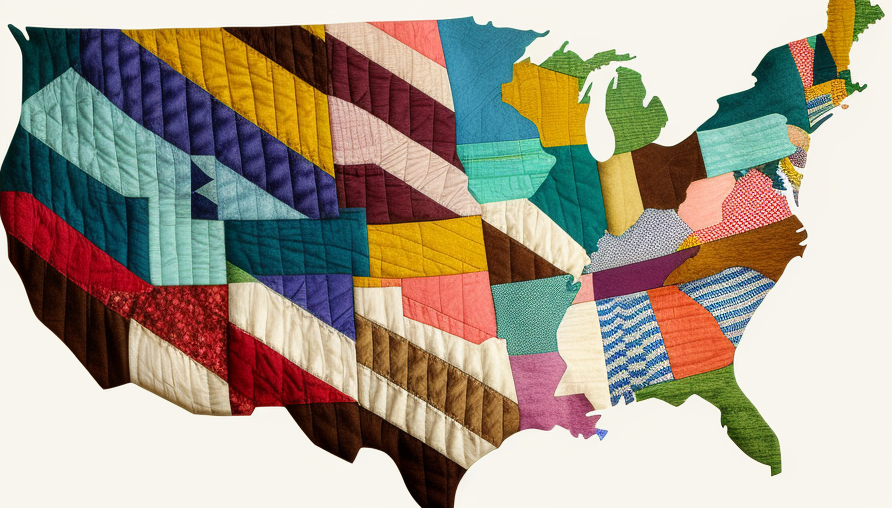Michigan, The New American Capital of… Weed?
A happiest of April 20th to those who celebrate. Let’s be real: Michigan perhaps isn’t exactly excelling at a whole lot these days. Contrary to the talking points, Gretchen Whitmer isn’t actually fixing the damn roads (except inasmuch as she is fixing future generations with debt to maintain MDOT’s overbuilt portfolio of highways). The state isn’t growing (although the wizards at MEDC seem to think a lil bit of good old corporate welfare for the automotive sector will fix it). But there’s one peculiar bright spot in the economy in that the state is shaping up to be one of the biggest markets in the country for– wait- cannabis?!
I’ll apologize in advance as this article is going to involve a number of puns that I find witty.
A State-By-State Patchwork Of Regulation
Often shockingly to Canadians or citizens of other civilized countries, the United States exists in a fragmented, contested, contentious patchwork of state regulatory frameworks given that the federal government can’t possibly be bothered to legalize cannabis, even as states like Michigan have. But Michigan’s a relative newcomer and has only recently lit up on the radar of national pot discourse.
Unlike Michigan, California and Colorado have long been considered the, ahem, high flyers in the cannabis realm, blazing new trails for the cannabis retail experience. In 2022, California’s market actually decreased in size for the first time possibly ever, from $5.8 billion to $5.3 billion. The Golden State legalized the devil’s lettuce in 2016, a full two decades after being the first state to legalize the use of medical marijuana. While perhaps no one was surprised by this, Michigan became the first Midwestern state to legalize recreational weed in 2018. And the market has really just taken off from there.

It’s not super easy to assemble clear data in some categories because the immature market for cannabis has fluctuated a great deal (evidenced in the huge price ranges of wholesale product in the table below). Taxes are also tough to compare because they can be assessed locally or at state levels, and they can be assessed at different points (i.e. excise tax, which is assessed at the point of manufacture, versus sales tax, assessed at the point of the retail transaction).
But comparing data from BDSA and a number of other sources and comparing across years, it seems that Michigan has, virtually overnight, jumped into the top five– nay, top three– cannabis markets in the country in terms of per capita spending (cannabis market size divided by population), even beating out California (about $135 per capita per year in 2022):
| State | Spending Per Capita/yr. | Wholesale – Flower (/lb) | Retail – Concentrate (1g) | Tax Rate |
| Colorado | $360 | $800-2500 | $10-50 | 17.9% |
| Oregon | $254 | $300-800 | $5-20 | 17% |
| Michigan | $230 | n/a | $5-30 | 16% |
| California | $110 | $700-2500 | $10-50 | 23-40% [2] |
| Nevada | $100 | $650-2000 [4] | n/a | 25% |
| Washington | $94 | $400-1500 | $10-40 | 37% |
| Ontario (Canada) | $9-11 (USD) | $350-450 (USD) [3] | n/a | 100% [3] |

Sticky Icky Product; Not-So-Sticky Prices
At first glance at the above table, you might notice that the states with the lowest per capita consumption of cannabis appears to have the highest tax rates. California banked on this higher revenue, which helped create a massive budget surplus– but wait, just kidding, actually. Michigan, on the other hand, as a state that lets you dump hexavalent chromium in the water because of our state’s Business-Friendly Regulatory Environment (BFRE), lacks such a conundrum. An immature cannabis market with the BFRE does, however, mean that it’s possible for us to more easily see what will happen to market demand over the first few years without the interference of Big Bad Government.
But the future of the market in Michigan is threatened by a double whammy of a general price collapse and an uncertain regulatory future in the United States at large. Observed Bart Schaneman last year in MJ Biz Daily:
…cannabis growers are spending at least $800 to grow a pound of flower and getting only $600 for it on the wholesale market […] a year ago a midgrade pound of indoor-grown wholesale flower that tested at around 20% THC potency would sell for $1,800-$2,200. Now, that same grower is lucky to get $600 a pound, and she’s heard of some selling for as low as $300.
MJ Biz Daily, July 2022. [link]
At $18.75 per ounce for the cheap stuff, that’s half of what most stoners were paying for an eighth in recent years. While all good things must come to an end for investors in market bubbles– see the NASDAQ, or anyone who bought into the crypto bubble- this is a great thing for consumers of this, ahem, supposed vice. It also means that there’s still a sky-high gross margin for raw flower, which means a lot of runway for market growth, competition, and innovation (whatever “innovation in cannabis” might mean). This is encouraging as a matter of intellectual curiosity. I would be lying if I said I had any idea what it meant for the long-term prospects for the market, though.
What happened to “Pot For Potholes“?
When the conversation about legalization first started, there was plentiful conversation about all of the infrastructure projects we could fund with simple taxes on weed. Nay, it seems like we in Michigan are not going to get there with the lowest combined tax rate among these top competitors. Compare this to Canada’s tax rate on weed, which can effectively exceed 100%– and comes from a federal excise tax that combines with provincial sales and value-added tax.
Conclusions: Business & Regulatory Complexities In Settling Market Froth
The more heavily fragmented a market is, the more complex it becomes to figure out what are already big challenges for a normal market. It becomes even worse when you consider that there are complicated laws that prevent cannabis from being trafficked across state lines (and, a reminder: cannabis is still federally illegal, although simple possession of small amounts of the drug is barely enforced by federal law enforcement authorities). This is why you might visit six dispensaries in six different states and see completely different products. Producers can source from cannabis in different jurisdictions, but only if they are selling those products in the jurisdictions in which the cannabis is grown.
The patchwork system of regulation can also provide opportunities for cannabis growers and users. As individual states experiment with different regulatory approaches, they can serve as laboratories for policy innovation. States with more progressive policies may attract cannabis-related businesses, investments, and tourism, spurring economic growth and job creation.
Despite the federal illegality of cannabis, companies have found ways to navigate the complex regulatory environment and operate in multiple jurisdictions. One strategy is to establish separate entities for each state in which they operate, allowing them to tailor their operations to the specific regulations of each jurisdiction. Additionally, some companies have chosen to focus on ancillary products and services, such as cultivation equipment or software solutions, which are less directly impacted by the federal prohibition on cannabis.
But the regulatory patchwork still seems to reward scale, in spite of itself: Michigan had legalized medical cannabis in 2008, and small growers enjoyed the better part of a decade with limited big money competition. Most of those small growers have been edged out of the market by a combination of price pressure and regulatory pressure that many critics have argued gave unfair advantages to bigger-scale operations. (What else is new?)
The Michigan cannabis market is still probably going to grow, as Ohio drags its feet on legalization, and as markets expand outside of Metro Detroit– namely in smaller towns whose main streets used to boast but a tanning salon and a farm implement store, and now will feature a recreational cannabis dispensary as well. It’s anyone’s guess what is going to happen with the rest of the American regulatory patchwork. One might think that the Democrats could improve their shot at 2024 with a federal push for legalization. Certainly, Michigan is enjoying the rosy haze of this new market, and will continue to, boom-bust cycles be damned.




